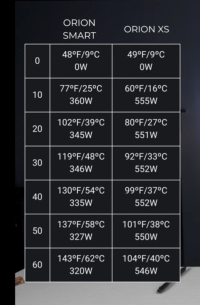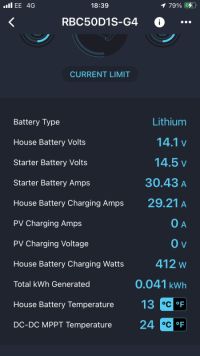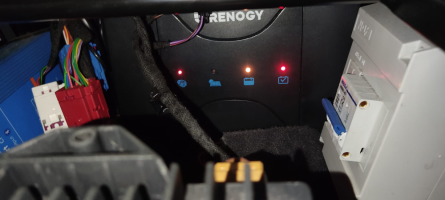@Dellmassive @Pete Baker are we talking about Ekrano GX vs Cerbo GX + GX Touch?
You are using an out of date browser. It may not display this or other websites correctly.
You should upgrade or use an alternative browser.
You should upgrade or use an alternative browser.
[Guide] DC-DC Charger (for leisure battery) -- How I Done It --
- Thread starter Dellmassive
- Start date
Renogy ,@Dellmassive @Pete Baker are we talking about Ekrano GX vs Cerbo GX + GX Touch?
new 50A IP67 dc-dc and the ONE core screen.
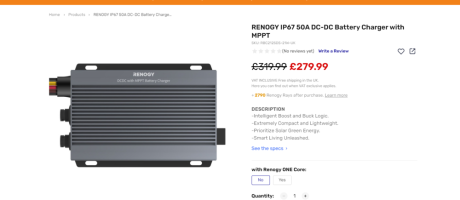
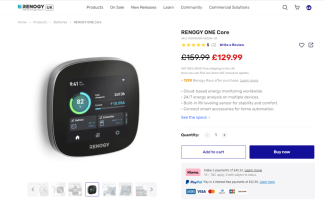
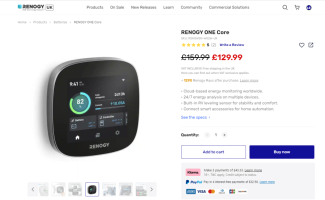
I’ve just bought one of these, arriving tomorrow after giving up trying to repair the CETEK. Not gone for the screen thoughRenogy ,
new 50A IP67 dc-dc and the ONE core screen.
View attachment 227342View attachment 227343
View attachment 227344
more on the Orion XS.
View attachment 226255
in the T6 we use the H pin to POS method.
View attachment 226256
.
ah !!! found it.
Low temperature cut-off (configurable for lithium batteries)Note that this setting only takes effect when the battery temperature isshared by other devices, for example by a BMV in a VE.Smart network
so the XS doesnt have its own temp sensor. . . . it needs a seperate one, either via VE network. (BT or hard wired?) from a BMS shunt or other?
View attachment 226257
.
ill go so is i can add it to the vans VE smart network thats setup from the Smarty Shunt. . .
tbc:
edit. . .
hold on. . . our BMV shunt is set to broadcast VE Smart temp data over BT.
View attachment 226259
but the Orion XS is not showing any VE Smart options?
View attachment 226260
so, looks like its just VE Direct hard wire link to the CERBO for now?
+++++
yep confirmed via Victron Tech support. . .
its not ready in the FW yet . . .
View attachment 226258
..
View attachment 226849
.
View attachment 226850
..
January 16th, 2024
Engineered from the ground up, the Orion XS redefines adaptive DC-DC charging. For use in dual battery systems charged with an (intelligent) alternator. This device not only ensures top-tier performance but also guarantees the safety of your system.
Stay in charge with configurable input and output currents, and rest assured that your Orion XS will run at full capacity up to 40°C. The innovative aluminium circuit board cooling technology delivers an astonishing 98% efficiency without the need for fans.
As an integral part of your Victron system, the Orion XS offers full (remote) monitoring and control capabilities, giving you complete command of your device and system.
For more information
- Fully configurable
- Engine shutdown detection
- Intelligent charge algorithms
- Works with VictronConnect
- Remote monitoring optional
- Product page: Orion XS 12/12-50A DC-DC Battery Charger - Victron Energy
- Professional vehicles: Professional Vehicles - Victron Energy
.
ORION XS . . continued
looks like Victron are slowly adding in the features for the new units.
we have a new BETA release of VICTRON CONECT, - VictronConnect changelog and beta releases [Victron Energy]
and a BETA for the VENUS OS on the CERBO GX - Venus OS v3.20~41 available for testing - Victron Community
...
with the updates and a VE-Direct cable plugged in we can now see and access the ORION XS remotely - SWEET !!!!
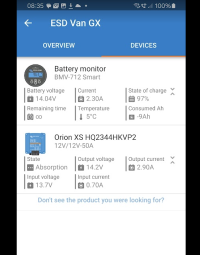
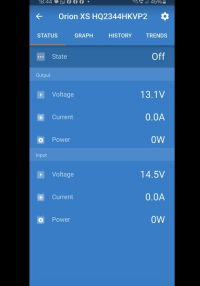
connecting up the IP65 25A BSC to the starter battery . . . we get , well nothing.
we can see the starter battery being charged at 14.5v, but the ORION is OFF. . .
other dc-dc chargers would have kicked in by now with the "Auto VST" feature.
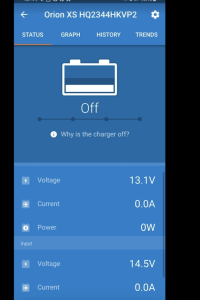
luckily victron has us covered and explains why its off. . .
the REMOTE - yep remember i wired the unit to the ENG RUN feed.
well thats keeping the charger off. . .
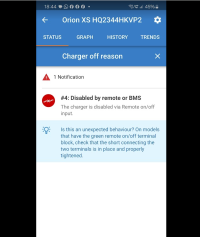
i trying to be clever. . . i remotely turn on the Smart Engine Shut Down feature. . .
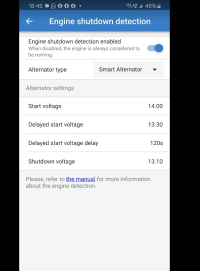
er nope . . . it wont have it.
the HL Remote pin is a HARD LOCK, ON or OFF.
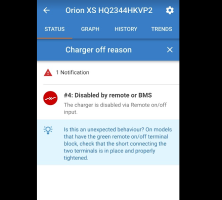
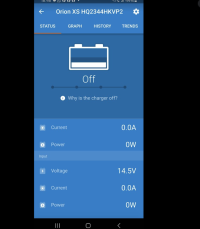
so i jumpped into the van.
removed the engine run feed,
and installed a jumper in the HL port.
now the Auto feature kicked into life. . . . assuming the engine was running from seeing the raised voltage from the charger. . . .
here we go. . . .charging away. . . 12A at this point.
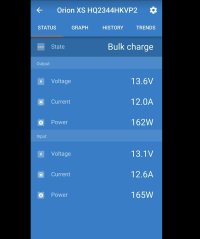
doubled checked here, we can see the same charge on the XS and Smart shunt.
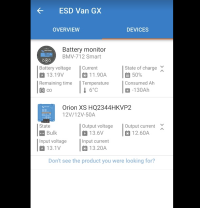
++++++++++++++++
i left it all running over night as the Fogstar 230ah battery was showing 50% soc.
next morning we see.
the XS showing 131ah charged over 10h 39m
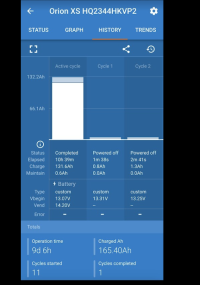
and now in float mode.
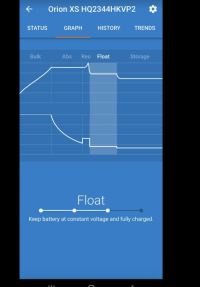
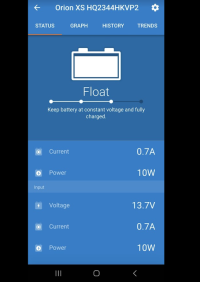
the shunt shows the battery at 96% soc,
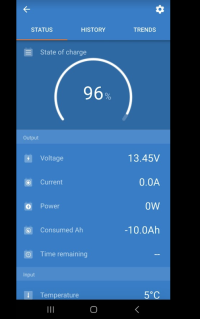
which is confirmed with the Fogstar APP.
so everything tallys up perfect.
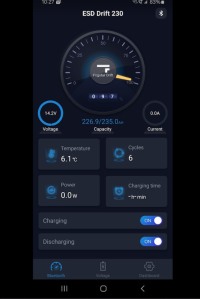
.....
very nice. . .
so, what I've learned from this is that victron is too clever. . .
using the H pin IGN ON - is a hard stop. . .
so where i normally just throw a charger on the starter battery. . . . and let it charge up and also charge the leisure battery via the DC_DC. - with this unit i need to be a bit smarter.
i think i need to add in a small switch that can be used to bridge the H&L pins to disable the H pin engine run?
or just leave the unit running automatic engine detection?
or a toggle switch to switch between either?
no sure yet. . . . but i have remote coms via the CERBO + WIFI to change any settings.
...
as a side note I've been playing with the new-ish GlobalLink 520.
it comes with a 5yr SIM plan and connects to VE-Direct & VE-Smart,
BUT - its not what i thought i was. . .
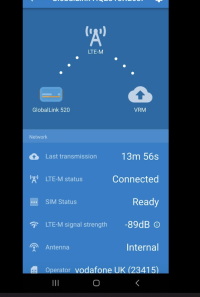
my issues. . .
it only updates evey 15mins fixed - so no live data.
no remote settings changes.
not on victron connect. .
so for now I've added it to the Domestic Solar setup to monitor voltages and temps. . .
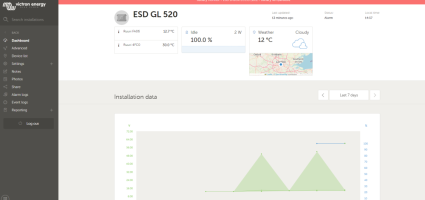
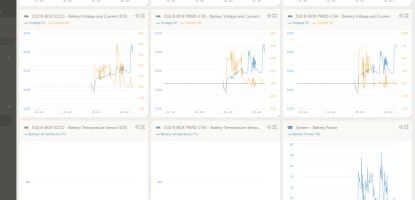
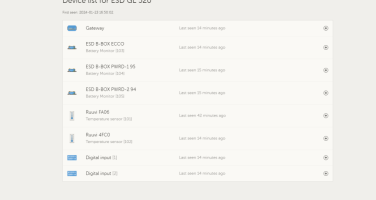
+++
if you want the full Victron VRM experience, then you need the CERBO S GX, which is the trimmed down version of the CERBO GX.
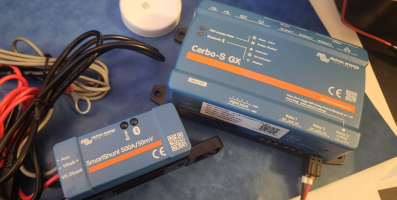
++++
.
The Previous run red hot at just 30A.. . .Interesting video on the Orion XS, aside from the massive size difference to the Orion TR, temps are a big improvement.
View attachment 227443
It seems to sits at 40 degrees max Vs the 60+ degrees (and still rising) of the Orion TR, and that's with no heatsink and putting out 50a Vs 30a!!
The XS is welcome move forwards....
It the unit we should have had years ago.
Yeah I've been checking every other day and there's none around at all.
I'm actually thinking of pre ordering one as I don't want to miss out on the stock when they come in, in late March...
Gets the cheapest I've seen, £265 for a pre-order.
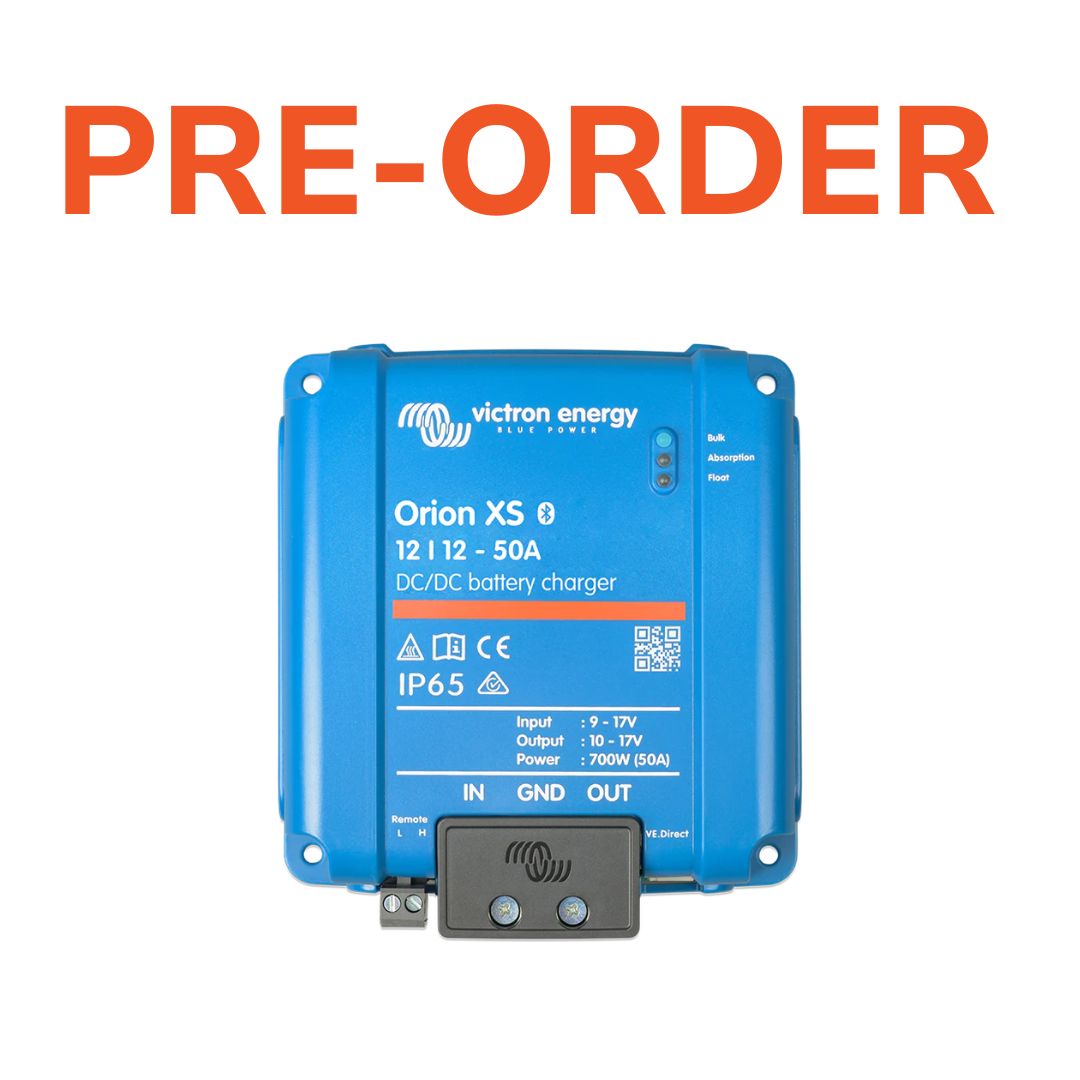
 batteriesandsolar.co.uk
batteriesandsolar.co.uk
I'm actually thinking of pre ordering one as I don't want to miss out on the stock when they come in, in late March...
Gets the cheapest I've seen, £265 for a pre-order.

Victron Orion XS 12/12-50A DC-DC Battery Charger - ORI121217040 | Default Title | Batteries & Solar
Batteries & Solar offers a diverse selection of chargers and accessories, with prompt deliveries from our Plymouth, Devon office. For inquiries about battery chargers, DC-DC chargers, or any other chargers, please contact us at 01752 656270 and our sales team will be happy to help.
just playing with the Charge voltage on the Orion XS and the effect on current charge rate.
+++++++++
The battery is around 80% SoC, so will accept way over the 50A the charger can deliver.
but the rate at which the current goes in is directly effected by the charger voltage (potential difference between the charge source and the battery)
so why is my battery not charging at 50A?
well the voltage of the battery rises fairly quickly making the charger move over to ABS stage, . . . which will hold the voltage, but reduce the current.
lets see what happens when we tweek the charge profile settings.
and ill redo the test with a lower SoC at some point so the battery stays in BULK mode for longer.
+++++++++
the default Victron profile is 14.2v
here i set it to 14.3v - that gave us 21.1A
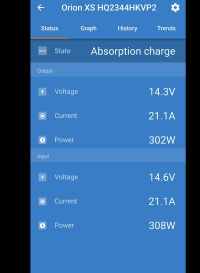
setting to 14.5v allows 29.3A charge rate.
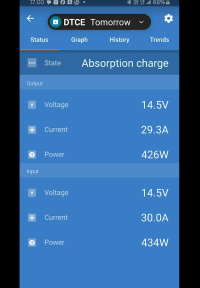
changing to 14.6v allows 33.4A (487w)
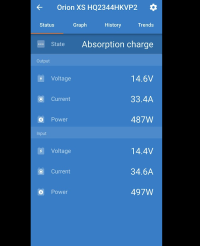
...
verified on the battery
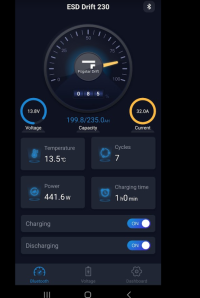
..........
going back to the default 14.2v drops the current back down to 18.6A
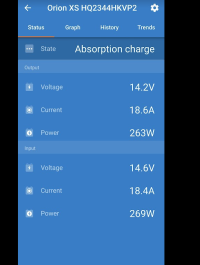
//
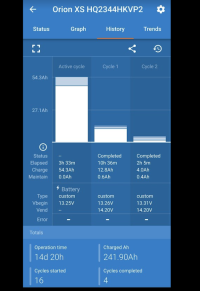
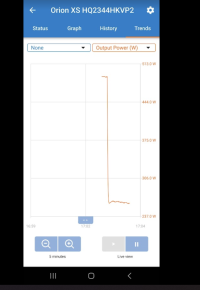
+++++++++
The battery is around 80% SoC, so will accept way over the 50A the charger can deliver.
but the rate at which the current goes in is directly effected by the charger voltage (potential difference between the charge source and the battery)
so why is my battery not charging at 50A?
well the voltage of the battery rises fairly quickly making the charger move over to ABS stage, . . . which will hold the voltage, but reduce the current.
lets see what happens when we tweek the charge profile settings.
and ill redo the test with a lower SoC at some point so the battery stays in BULK mode for longer.
+++++++++
the default Victron profile is 14.2v
here i set it to 14.3v - that gave us 21.1A

setting to 14.5v allows 29.3A charge rate.

changing to 14.6v allows 33.4A (487w)

...
verified on the battery

..........
going back to the default 14.2v drops the current back down to 18.6A

//


here they are . . .Renogy ,
new 50A IP67 dc-dc and the ONE core screen.
View attachment 227342View attachment 227343
View attachment 227344
go check it out.
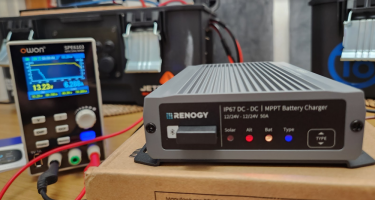
..

[Guide] Renogy IP67 50A DC-DC Charger + MPPT (for leisure battery) -- How We Done It --
[Guide] Renogy IP67 50A DC-DC Charger + MPPT (for leisure battery) -- How We Done It -- .. with thanks to a Forum Member for buying this for himself, but sending it to me first to test it out. we have the new .. RENOGY IP67 50A DC-DC Battery Charger with MPPT RENOGY 12V/24V IP67 50A...
...
@DellmassiveI've had this unit since summer 2020 . . . but with all the Solar stuff doing the rounds i forgot about it.
i think its time to dig it out . . .
Renogy 20A DC-DC charger. - RNG - DCC1212-20-EU
View attachment 103983
Description:
The DCC12 Series battery chargers are the most effective way to charge your auxiliary or house batteries from the alternator/starter battery. Compatible with a multitude of alternator types, the DCC12 offers correct charging for AGM, Flooded, Gel, and even Lithium deep cycle batteries!
Featuring a 3-stage battery charger and multiple electronic protections, owners can feel confident that their batteries are being charged optimally and automatically. For added safety to personnel, the DCC12 isolates the input from the output preventing incorrect voltage transmission. Easily install the compact yet sturdy DC1212 on RV’s, commercial vehicles, boats, yachts and many more applications!
- Multi-Chemistry Battery Types: AGM, Flooded, Gel, and Lithium
- Smart Protection Features: Over-voltage safety, Overheat protection, and Reverse polarity protection
- Battery Input and Output Isolation
- 3-phase Charging: Bulk, Boost, and Float
- Compact, sturdy design, built tough for all conditions
- Increases run time of loads, such as fridges and lights
- Overcomes voltage drop caused by long cable runs
- Prolongs Battery Life
this is my one . . . . . out the box and rearing to go.
View attachment 103984
connection wise we have main power out, with sensor input, DIP switch setting and status LEDs . .
View attachment 103985
the terminals are nice and chunky . . .
View attachment 103988
the other side we have the input and some fans . . .
View attachment 103989
not much to see in the base . . .
View attachment 103990
..
the black covers clip off to get access to the 6mm screw bolts for the main cables.
View attachment 103991
.
As you know i use 50A Anderson connectors in the van as quick disconnects so that i can swap out chargers as and when i need to for testing and playing about . . .
this is a 20A unit, so 50A Anderson connectors will be fine . . .
So lets make some cables up.
View attachment 103992
..
10AWG Silicone high temp flexible cable is double crimped onto the pin ends . . .
View attachment 103993
and snapped into place inside the housing . . .
View attachment 103994
in and out side made up we move the units connections. . . . . a 6mm screw bolt for this unit.
View attachment 103995
.
i had a rummage and found these 6mm luggs that look suitable. . . .
View attachment 103996
.
View attachment 103997
..
cut some heatshrink . . .
View attachment 103998
.
double crimp on . . .
View attachment 103999
.
and apply heat . . .
View attachment 104000
.
take the cover off . . .
slide cables through . . .
take out bolts . . .
screw down tight . . .
replace cap . . .
View attachment 104001
..
this is what we end up with . . .
View attachment 104002
...
following the manual:
View attachment 104003
.
View attachment 104004
.
D+ we can run an IGN feed to this terminal
S1-S5 is the battery type setting.
end of part1
@Dellmassive Lee I’m just fitting one of these at the moment. It’s odd to me that it has a ground on the input side AND a ground on the output side.I've had this unit since summer 2020 . . . but with all the Solar stuff doing the rounds i forgot about it.
i think its time to dig it out . . .
Renogy 20A DC-DC charger. - RNG - DCC1212-20-EU
View attachment 103983
Description:
The DCC12 Series battery chargers are the most effective way to charge your auxiliary or house batteries from the alternator/starter battery. Compatible with a multitude of alternator types, the DCC12 offers correct charging for AGM, Flooded, Gel, and even Lithium deep cycle batteries!
Featuring a 3-stage battery charger and multiple electronic protections, owners can feel confident that their batteries are being charged optimally and automatically. For added safety to personnel, the DCC12 isolates the input from the output preventing incorrect voltage transmission. Easily install the compact yet sturdy DC1212 on RV’s, commercial vehicles, boats, yachts and many more applications!
- Multi-Chemistry Battery Types: AGM, Flooded, Gel, and Lithium
- Smart Protection Features: Over-voltage safety, Overheat protection, and Reverse polarity protection
- Battery Input and Output Isolation
- 3-phase Charging: Bulk, Boost, and Float
- Compact, sturdy design, built tough for all conditions
- Increases run time of loads, such as fridges and lights
- Overcomes voltage drop caused by long cable runs
- Prolongs Battery Life
this is my one . . . . . out the box and rearing to go.
View attachment 103984
connection wise we have main power out, with sensor input, DIP switch setting and status LEDs . .
View attachment 103985
the terminals are nice and chunky . . .
View attachment 103988
the other side we have the input and some fans . . .
View attachment 103989
not much to see in the base . . .
View attachment 103990
..
the black covers clip off to get access to the 6mm screw bolts for the main cables.
View attachment 103991
.
As you know i use 50A Anderson connectors in the van as quick disconnects so that i can swap out chargers as and when i need to for testing and playing about . . .
this is a 20A unit, so 50A Anderson connectors will be fine . . .
So lets make some cables up.
View attachment 103992
..
10AWG Silicone high temp flexible cable is double crimped onto the pin ends . . .
View attachment 103993
and snapped into place inside the housing . . .
View attachment 103994
in and out side made up we move the units connections. . . . . a 6mm screw bolt for this unit.
View attachment 103995
.
i had a rummage and found these 6mm luggs that look suitable. . . .
View attachment 103996
.
View attachment 103997
..
cut some heatshrink . . .
View attachment 103998
.
double crimp on . . .
View attachment 103999
.
and apply heat . . .
View attachment 104000
.
take the cover off . . .
slide cables through . . .
take out bolts . . .
screw down tight . . .
replace cap . . .
View attachment 104001
..
this is what we end up with . . .
View attachment 104002
...
following the manual:
View attachment 104003
.
View attachment 104004
.
D+ we can run an IGN feed to this terminal
S1-S5 is the battery type setting.
end of part1
The input side gnd I’ve connected to the body gnd point under the seat.
Am I right that I have to run the output gnd from the Renogy unit to the LB then the ground from the LB to the body gnd?
Or does this gnd cable from Renogy to LB mean I don’t need to gnd the LB?
Hope that makes sense.
Both grounds need to go to the van chassis...... They do that for fiberglass RVs etc.
As do both the battery grounds.
So both grounds to van NEG.
And battery POS connections via a fuse at the battery terminals.
As do both the battery grounds.
So both grounds to van NEG.
And battery POS connections via a fuse at the battery terminals.
Cheers Lee. Pos all sorted and correctly fuses etc.Both grounds need to go to the van chassis...... They do that for fiberglass RVs etc.
As do both the battery grounds.
So both grounds to van NEG.
And battery POS connections via a fuse at the battery terminals.
So just to confirm, even though it seems obvious, I can connect both input AND output gnd to the same gnd stud under the passenger seat.
Yep. Defo.... Same ground stud is perfect.Cheers Lee. Pos all sorted and correctly fuses etc.
So just to confirm, even though it seems obvious, I can connect both input AND output gnd to the same gnd stud under the passenger seat.
Lee, some simple Q'sjust playing with the Charge voltage on the Orion XS and the effect on current charge rate.
+++++++++
The battery is around 80% SoC, so will accept way over the 50A the charger can deliver.
but the rate at which the current goes in is directly effected by the charger voltage (potential difference between the charge source and the battery)
so why is my battery not charging at 50A?
well the voltage of the battery rises fairly quickly making the charger move over to ABS stage, . . . which will hold the voltage, but reduce the current.
lets see what happens when we tweek the charge profile settings.
and ill redo the test with a lower SoC at some point so the battery stays in BULK mode for longer.
+++++++++
the default Victron profile is 14.2v
here i set it to 14.3v - that gave us 21.1A
View attachment 228185
setting to 14.5v allows 29.3A charge rate.
View attachment 228186
changing to 14.6v allows 33.4A (487w)
View attachment 228187
...
verified on the battery
View attachment 228188
..........
going back to the default 14.2v drops the current back down to 18.6A
View attachment 228189
//
View attachment 228190View attachment 228191
first personal your opinion.................... is this the Orion we always wanted?
2nd did the above post tell me if my LI FE PO4 batt likes being charged at say for example 14.2 V...that the XS can't bung 50A into that batt platform?
3rd where's your temp sensor on the BMV? IE so ya can access low temp disconnect via VE smart network
Mate not the sharpest tool in the box right now been a grueling 2 days into one on price today but I've tried to assimilate what you have gone through and those 3 seem to be my main Q's amongst many
Ta muchly
stu
stoic
Member
"Battery type indicator" - if you have lithium battery, you should make that one blue instead of red. But double-check with the manual that came with your DC to DC charger.
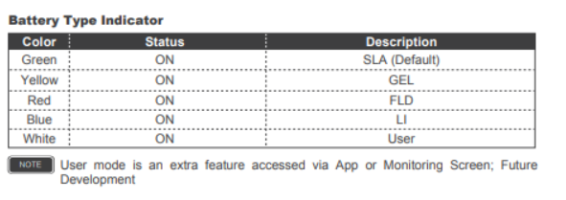
"Flooded or "wet cell" batteries are the most commonly used batteries on the market today. Flooded batteries come in the widest variety of shapes and sizes due to their widespread usage in a multitude of industries and applications. Flooded batteries again use lead plates, a sulfuric acid electrolyte, and plate separators but that is where it stops. Usually flooded batteries are not sealed, and do not recombine the gases to liquids internally. Instead, these gases are vented externally. Internal gases produced are released directly to the environment. Through these same vents can flow acid, steam, and condensation, leading to maintenance. Flooded batteries do require maintenance, in the form of water, to routinely replenish lost electrolyte through the vents. Lead plates start to deteriorate when they touch the atmosphere, so if you fail to maintain your batteries, they will corrode and fail. Flooded batteries hold very good rates of charge for the price, but require more work. Unfortunately due to the internal construction, flooded batteries have the weakest internal construction, and some very high internal resistance statistics."
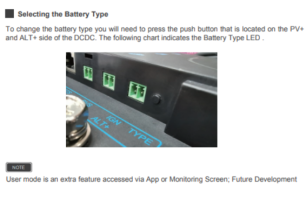

"Flooded or "wet cell" batteries are the most commonly used batteries on the market today. Flooded batteries come in the widest variety of shapes and sizes due to their widespread usage in a multitude of industries and applications. Flooded batteries again use lead plates, a sulfuric acid electrolyte, and plate separators but that is where it stops. Usually flooded batteries are not sealed, and do not recombine the gases to liquids internally. Instead, these gases are vented externally. Internal gases produced are released directly to the environment. Through these same vents can flow acid, steam, and condensation, leading to maintenance. Flooded batteries do require maintenance, in the form of water, to routinely replenish lost electrolyte through the vents. Lead plates start to deteriorate when they touch the atmosphere, so if you fail to maintain your batteries, they will corrode and fail. Flooded batteries hold very good rates of charge for the price, but require more work. Unfortunately due to the internal construction, flooded batteries have the weakest internal construction, and some very high internal resistance statistics."

Last edited:
Similar threads
- Replies
- 4
- Views
- 447
- Replies
- 24
- Views
- 2K
- Replies
- 36
- Views
- 2K
- Replies
- 42
- Views
- 1K

